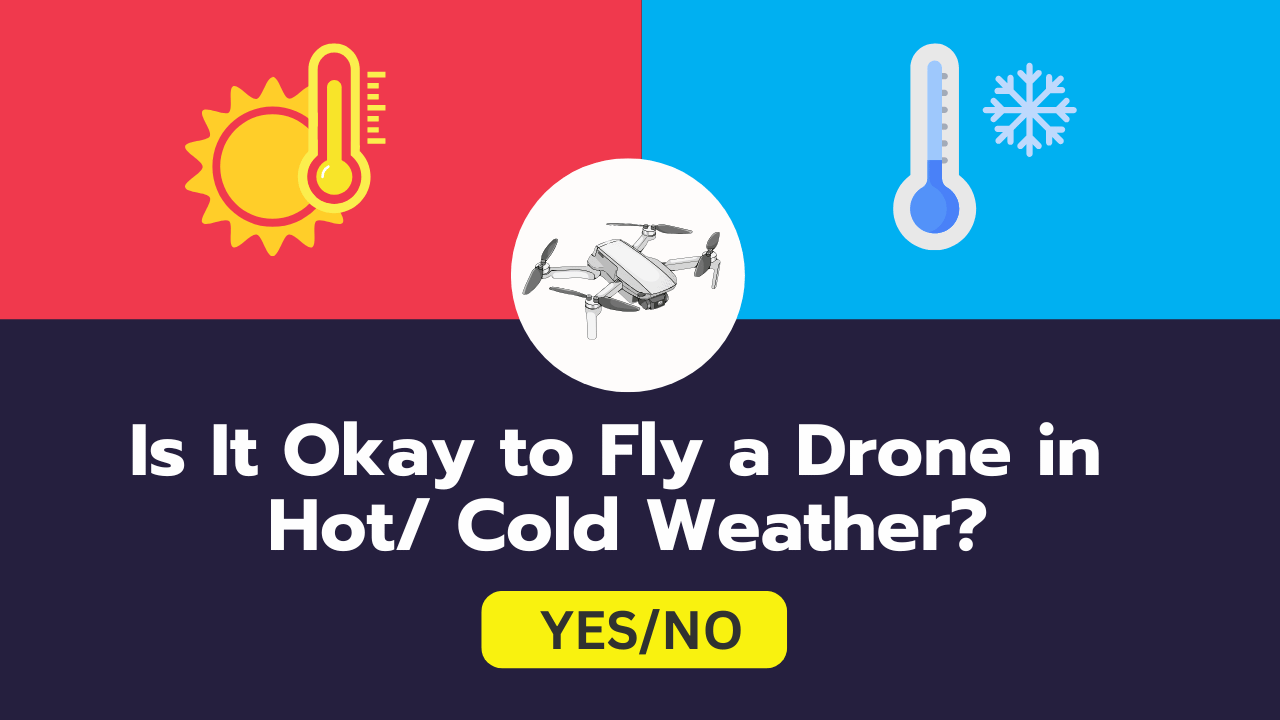Flying drones has become a popular activity, from capturing stunning landscapes to delivering packages and surveying land. But if you’re a drone enthusiast or just getting started, you might wonder, “Is it okay to fly a drone in hot weather?” Temperature can play a significant role in your drone’s performance, so let’s break down what you need to know to fly safely and keep your drone in good shape.
Table of Contents
What Temperature Can You Fly a Drone?

Most drones are designed to function within a temperature range, often around 32°F (0°C) to 104°F (40°C). However, each drone has unique specifications, and it’s essential to check the manufacturer’s recommendations. Flying in extreme temperatures outside this range can impact battery life, engine performance, and even the drone’s ability to stay in the air.
In Hot Weather
When flying in hot weather, keep in mind that high temperatures can cause your drone to overheat, affecting the motors and battery efficiency. Generally, staying below 104°F (40°C) is recommended. If you’re flying in temperatures close to or above this range, consider taking extra breaks to cool down the drone and avoid long flights.
In Cold Weather
Cold temperatures, on the other hand, can be just as challenging. When temperatures drop below 32°F (0°C), battery performance decreases, and propellers can become stiff, making it harder for the drone to maintain stability. Some high-quality drones are designed to operate in colder conditions, but it’s still wise to limit your flight time in chilly weather.
How Cold Is Too Cold to Fly a Drone?
Cold weather can affect your drone in many ways, particularly the battery. The lithium-polymer (LiPo) batteries in most drones lose efficiency in low temperatures, often draining faster and struggling to maintain power. Here’s a closer look at what happens in colder temperatures:
- Battery Life: Battery capacity decreases as temperatures fall, making it essential to keep batteries warm before and between flights.
- Control Sensitivity: Motors may become less responsive, impacting control.
- Condensation Risks: Flying in extremely cold weather could also lead to condensation when bringing your drone back indoors. This moisture can damage internal components.
For most drones, it’s advisable to avoid flying below 32°F (0°C) unless you have a specific model rated for colder climates. If you need to fly in colder temperatures, warming up your batteries and limiting flight time can help prevent issues.
Can You Fly a Drone in Freezing Weather?
Yes, it’s possible to fly a drone in freezing weather, but with certain precautions. Here are some tips to keep in mind:
- Pre-Warm Batteries: Start with warm batteries to help maintain energy output.
- Limit Flight Time: In freezing weather, try to fly for shorter periods, as batteries drain much faster.
- Check Firmware: Some drones have firmware adjustments for cold-weather operation. Make sure your drone’s software is up to date.
- Monitor for Condensation: Keep an eye out for condensation on the camera or inside the drone body, which can occur as the drone warms up.
Flying in freezing weather isn’t impossible, but it does come with added challenges. Make sure to take precautions to protect your drone and keep it functioning smoothly.
Can You Fly a Drone When It’s Snowing?
Flying in snow can be risky due to visibility issues and moisture exposure. Drones are electronic devices and not typically waterproof, so snow and moisture can damage the internal circuitry. Here are some things to consider:
- Moisture Protection: Snowflakes landing on the drone can melt, creating water droplets that may seep into the electronics and cause malfunctions.
- Visibility: Snow reduces visibility, which can affect the drone’s sensors and camera view.
- Flight Stability: Snow can affect a drone’s flight stability, especially if wind conditions are present.
If you choose to fly in snowy conditions, use a waterproof cover for your drone, avoid heavy snowfall, and keep your flights short. However, it’s generally better to avoid flying in snow altogether if possible.
FAQ: Frequently Asked Questions
What Temperature is Too Hot to Fly a Drone?
Drones generally perform best below 104°F (40°C). Flying above this temperature increases the risk of overheating, which can harm the battery, motors, and sensors.
When Should You Not Fly a Drone?
Avoid flying in extreme temperatures (above 104°F or below 32°F), heavy rain, snow, or strong winds. Also, do not fly in restricted zones or areas with poor visibility.
Does Heat Affect Drone Batteries?
Yes, heat significantly affects drone batteries, often leading to faster power drain, swelling, or even failure. Flying in high temperatures can reduce overall battery lifespan.
What Happens When Drones Overheat?
Overheating can cause drones to lose power mid-flight, damage the internal components, and reduce battery efficiency. This could result in a sudden crash or expensive repairs.
Final Wrap up Wordings
While flying a drone in hot weather is possible, it’s essential to understand the potential effects of high temperatures on performance, battery life, and safety. Following manufacturer recommendations and taking breaks during flight can help prevent overheating.
Likewise, cold weather, snow, and freezing temperatures bring their own set of challenges, requiring extra precautions to keep your drone in top condition. By planning around weather conditions and understanding how temperatures affect your drone, you can ensure safer flights and a longer-lasting device.


